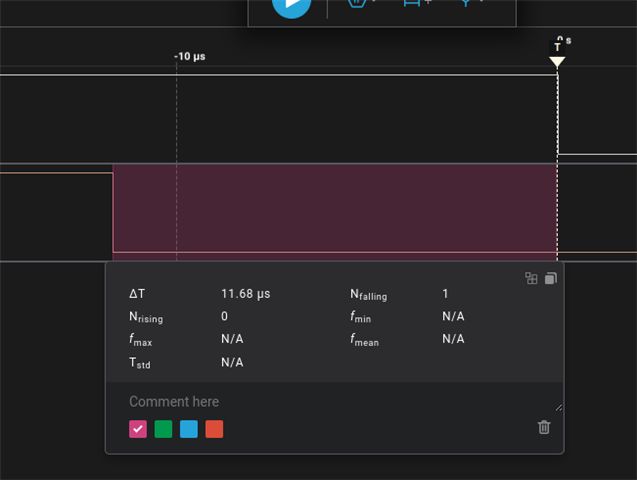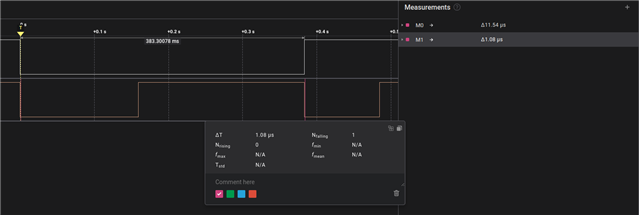My application requires one relatively low latency (<10 us) GPIO interrupt. I am using NCS 2.4.2 and running the code out of flash. The GPIOTE peripheral's interrupt has a bunch of scaffolding to deal with the multiplexed PORT interrupts, Zephyr GPIO driver abstraction, etc. To avoid that I've configured a GPIOTE channel to generate a PPI event which is used to trigger a dedicated interrupt on an EGU. This EGU's ISR is configured using IRQ_DIRECT_CONNECT and IRQ_ZERO_LATENCY and has a minimal amount of software overhead. Functionally this works as expected, however the typical latency from GPIO edge to ISR entry is still too high. To Illustrate this I've captured Salae traces where Channel 0 corresponds to the input signal to the GPIO and Channel 1 is a different GPIO which is toggled from the ISR (and is the only thing the ISR does).

It can be seen that the first latency within a burst is 15.5 us and subsequent ones are 15.0 us. The final one is 3.3 us, due to the fact that the CPU has not managed to go back to IDLE by the time the transition occurred.
That seems reasonable given that the SOC is in low power mode by default, but triggering the CONSTLAT task makes surprisingly little difference.

As can be seen above, this only shaved off about 0.5 us from the IDLE latencies. This is a somewhat dubious savings given that the typical HFINT startup time is supposed to be 3.2 us.
To ensure that a HFCLK is indeed running while the CPU is in WFI I enabled a periodic TIMER to run in the background as well.

This did not affect the initial 15.0 us latency but did reduce the subsequent IDLE latencies by another 0.4 us.
Next I tried enabling the HFXO.

This decreased the initial latency but increased the subsequent ones, suggesting that the difference is primarily due to the state of the HFINT. Though I'm not too worried about this difference, and really just need to get the typical latency much more similar to the final one.
To further prove that the high latencies are associated with a wake from IDLE I captured a trace with the same firmware running but with the debugger connected.
 As you can see, all latencies are now between 4.0-4.3 us. Since the final latency is now equivalent to the others this corroborates the original theory that the CPU had simply not made it back to WFI by the time that interrupt occurred.
As you can see, all latencies are now between 4.0-4.3 us. Since the final latency is now equivalent to the others this corroborates the original theory that the CPU had simply not made it back to WFI by the time that interrupt occurred.
If I disconnect the debugger but simply comment out the WFI instruction from within arch_cpu_idle I get similar results. If I also re-disable the HFXO the latencies further decrease by about 0.5 us.

This suggests that waking from system ON IDLE incurs over 10 us of unavoidable latency, regardless of running in constant latency mode or the HFINT status. If I use the PPI to trigger a GPIOTE task to toggle the output GPIO I see a latency of only ~400 ns. This confirms that the latency relates to the CPU and not the peripherals. To me this seems unexpectedly high, though I don't any documentation in the product spec which specifies the expected values. I also don't see any other relevant cases in DevZone for NRF9x, but NRF5x seem to be capable of lower latencies.
Is this expected or a known issue? Is there anything that can be done to avoid it (other than completely avoiding WFI)?




